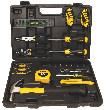A great way to save space while maintaining privacy is to install a pocket door. Traditional doors need room to swing open. Pocket doors slide inside of the adjacent wall (the "pocket") when open, and out of the wall and into the doorframe when closed. You can find pocket doors in many sizes, including 36-, 32-, 30-, 28, and 24-inch doors. The door's wheels or casters slide on the metal rail located on the floor of the pocket, or on a track installed at the top of the pocket, or both.
Because of the space needed inside of the wall to house the door, and the process involved with installing the tracks, pocket doors can be more difficult to install than traditional doors. Before you purchase a pocket door kit at your local home improvement store, make sure that you prepare the frame for the door, and that you leave enough room for the equivalent of two doors. Follow these guidelines for installing a pocket door:
You can attach drywall to the frame, if you'd like, smooth and finish the wall and seams. Never use nails when installing a pocket door, as nails in the wall will impede the door's flow. If you've purchased a door handle and lock for your pocket door, install the lock according to the instructions on the package. If you have an uncut doorframe, you will need to use a chisel to cut a depth for the locking mechanism. Follow the instructions on the package to do so.

Find the Right Tool Right Away Finally, a homeowner's set that includes all the tools needed to complete basic DIY projects at an affordable price! The tools are stored in a molded case for security and portability. Check out Stanley 65-Piece Homeowner's Tool Kit today!
Installing energy efficient doors is a great way to help reduce your overall heating or cooling bills. While you could ...
Discover MoreA squeaky door results from a squeaky hinge. Lubricate all parts of your door hinge and then reinstall the door. Chances ...
Discover MoreKeeping up on the maintenance of your doors can help prevent having to replace parts as well as avoid the frustration of ...
Discover MoreThere are currently no comments for this tip. (Be the first to leave your comment—just use the simple form above!)
Copyright © 2025 Sharon Parq Associates, Inc.
Comments